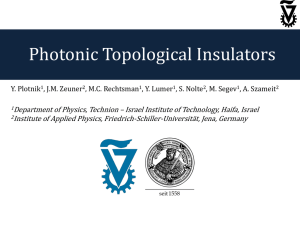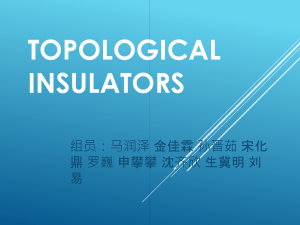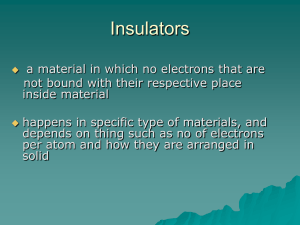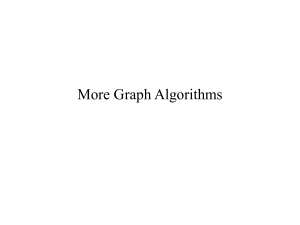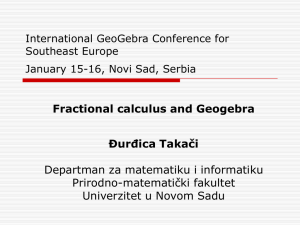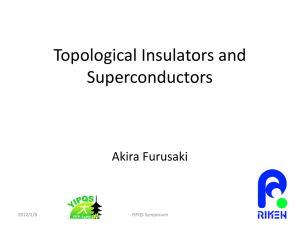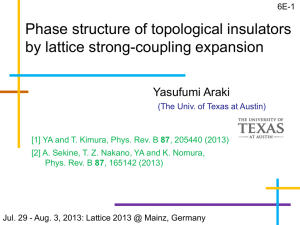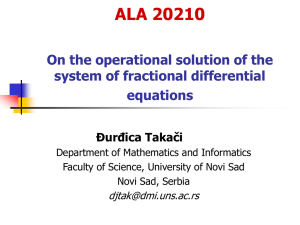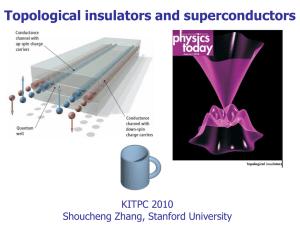255
advertisement
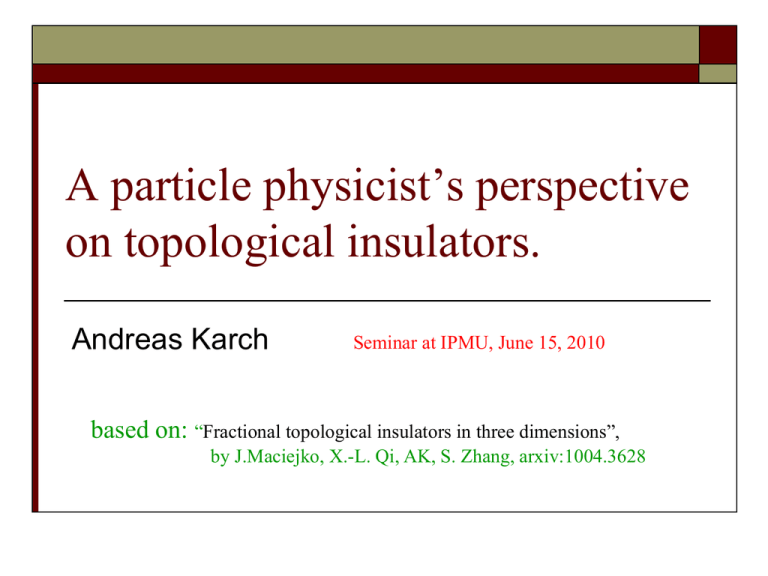
A particle physicist’s perspective on topological insulators. Andreas Karch Seminar at IPMU, June 15, 2010 based on: “Fractional topological insulators in three dimensions”, by J.Maciejko, X.-L. Qi, AK, S. Zhang, arxiv:1004.3628 Part I: Motivation and Summary. What is a topological insulator? Preview of fractional topological insulator. 2 Basic Tool: Effective Theory Standard strategy to determine low energy physics of a system with unknown or too complicated microscopic physics: 1. Guess correct light degrees of freedom. 2. Write down most general Lagrangian with least number of derivatives consistent with symmetries. 3. Determine unknown constants by “matching” or experiment. 3 Basic Tool: Effective Theory Examples: QCD: SU(3) YM → Mesons → chiral Lagrangian→ fπ. Any substance close to equlibrium: ?→ Energy density → Navier-Stokes → P(E), η Note: One Way Street! UV → IR 4 Effective theory on insulators. What is the low energy description of a generic, time reversal invariant insulator? Insulator = gapped spectrum Low energy DOFs: only Maxwell field. Task: Write down the most general action for E and B, with up to two derivatives, consistent with symmetries. 5 Low energy effective action. Low energy DOFs: only Maxwell field. Permittivity and Permeability. 6 Rotations allow one extra term. 3 d xdt ( E B ) But: Under time reversal E is even, B odd So naively the most general description of a time reversal invariant insulator does not allow for a theta term. 7 Flux Quantization. Dirac Quantization of magnetic charge: e gn 2 Implies quantization of magnetic flux! S F g On any Euclidean closed 4-manifold M: 8 Flux Quantization w/o monopoles. B dS A dl e As the electron encircles the flux, it picks up a phase Φ. Single valued wavefunction requires quantized flux! On any 4-manifold M: 9 Flux Quantization. Partition function is periodic in +2 (Abelian version of the “ vacuum” (Callan, Dashen, Gross 1976, Jackiw&Rebbi, 1976)) is time-reversal odd time-reversal invariant insulator can have =0 or Z2 classification 10 Topological Insulators Low energy description of a T-invariant insulator described by 3 parameters: ε, μ, and: 11 Physical Consequences. Theta term is total derivative. In the absence of interface can be absorbed by redefining E and B. But: Boundary of topological insulator = domain wall of 12 Physical Consequences. E 4P=(-1)E B 4P=(/2)B B A topological term in the action 4M=(1-1/)B E 4M=(/2)E 13 Magnetic Monopoles in TI prediction: mirror charge of an electron is a magnetic monopole first pointed out by Sikivie, re-obtained in the TI context by Qi et. al. Compact expression from requiring E&M duality covariance (AK). (for =’, =’) 14 Faraday and Kerr Effect change in θ B independent contribution to Kerr/Faraday (Qi et al) (Polarization of transmitted and reflected wave rotated by angle θ) 15 Permittivity and Permeability. Mirror charge and Kerr/Faraday angle depend on θ as well as ε and μ. While θ is quantized, ε and μ are not. Quantum Hall physics (2+1 dimensions): Chern Simons dominates, Maxwell irrelevant Topological Insulator (3+1 dimensions): Maxwell term and the topological term marginal! 16 Faraday and Kerr Effect Kerr and Faraday together can give quantization! (Maciejko et al) 17 What’s coming up: A simple microscopic model mapping the properties of θ to the chiral anomaly. Review of experimental results on topological insulators. 18 Fractional Topological Insulators. This discussion will be modified if there are additional light degrees of freedom. As long as all charge carriers are gapped we still describe an insulator (in fact even conventional insulators have light phonons). I’ll give examples of effective theories that give rise to theta being π/(odd integer). 19 Part II: Anomalies and fTI’s Microscopic Example in a continuum field theory and the ABJ anomaly. Fractional Topological insulators in 3+1 dimensions. 20 A Microscopic Model A microscopic model: Massive Dirac Fermion. Time Reversal: M M Time reversal system has real mass. Two options: positive or negative. * 21 Chiral rotation and ABJ anomaly. Massless theory invariant under chiral rotations: Symmetry of massive theory if mass transforms: Phase can be rotated away! Chose M positive. 22 Chiral rotation and ABJ anomaly. But in the quantum theory chiral rotation is anomalous. Measure transforms. C fields q 1 1 1 2 2 Single field with unit charge. 23 Chiral rotation and ABJ anomaly. Axial rotation with Φ=π: Rotates real negative mass into positive mass. Generates θ=π! Positive mass = Trivial Insulator. Negative mass = Topological Insulator. 24 Localized Zero Mode on Interface. Domain Wall has localized zero mode! Kaplan’s Domain Wall Fermion Domain Wall = TI/non-TI Interface 25 The boundary point of view. Surface state stable against perturbations: * T-invariance does not allow for mass term * “Dirty” surface layer can only add/remove fermions in pairs! (Nielsen/Ninomiya) * Single 2+1 fermion has parity anomaly * Hall conductivity can be shifted by integers; half-integer contribution robust Surface zero mode =experimental signature! 26 Generalizations: Boundary theory With anomaly Bulk topological insulator 4+1 Callan-Harvey, Kaplan Z axial anomaly 3+1 3+1 TRI topological insulator Z2 parity anomaly 2+1 2+1 Quantum Hall Z chiral anomaly 1+1 27 A Lattice Realization. How to get θ =π from non-interacting electrons in periodic potential (Band-Insulator)? Topology of Band Structure! Define Z2 valued topological invariant of bandstructure to distinguish trivial (“positive mass”) from topologically non-trivial (“negative mass”). 28 TKKN theory of Quantum Hall. (Thouless, Kohmoto, Nightingale, den Nijs) “Berry Connection” has quantized flux. xy 2 e m h 29 TKKN for topological insulator. Multi-Band-Berry-Connection. (Qi, Hughes, Zhang) θ=0 Vacuum, … θ=π Bi1-xSbx, Bi2Se3, Bi2Te3, Sb2Te3 30 predicted: TlBi(Sb)Te(Se, S)2 , LaPtBi etc (Heusler compounds) Experimentally found Zero Modes. Hasan group, Nature 2008 H. J. Zhang, et al, Nat Phys 2009 Hasan group, Bi2Se3 Nat Phys 2009 Bi2Te3 Chen et al Science 2009 Summary of Strategy: Low Energy Effective Theory: Dirac Quantization θ= Integer ∙ π IR Microscopic Model: ABJ anomaly θ/π= (charge)2 Connection to Experiment: Band Topology θ= QHZ-invariant UV 32 Fractional Topological Insulators? Recall from Quantum Hall physics: electron e- interactions xy e2 n h Quantum Hall fractionalizes into m partons xy (m odd for fermions) n e2 m h Fractional Quantum Hall 33 Fractional Topological Insulators? TI = half of an integer quantum hall state on the surface expect: fractional TI = half a fractional QHS Hall quantum = half of 1/odd integer. Can we get this from charge fractionalization? 34 Partons. Microscopic Model: θ/π= (charge)2 ABJ anomaly e- electron breaks up into m partons. = 2 1 1 / (charge ) m m m 2 (m odd so e- is fermion) 35 (if partons form a TI = have negative mass) Trial Wavefunction. Recall fractional QHE (“projective construction”): Parton wavefunction = Slater determinant of integer QHE: Electron wavefunction = all partons on top of each other: 36 Trial Wavefunction for FTI. Parton wavefunction = Slater determinant (e.g. from lattice Dirac model): Electron wavefunction : 37 Partons. e- = To ensure that partons confine into electron add “statistical” SU(m) gauge field Simplest model: SU(3) with Nf=1 38 Relativistic Partons. In a relativistic field theory the electron=baryon has spin m/2 in the SU(m) model. Not a problem in non-relativistic context. Alternative: Quiver Model Still need m partons to be gauge invariant. Baryons of any spin possible. 39 General Parton model. Total number of partons. 40 General Parton model. 41 Fractional θ and Dirac Quantization Why is fractional θ allowed from the point of view of Dirac quantization? Basic electric charge: e/m Basic magnetic charge: m g 42 Important dynamical question. Is the gauge theory in a confining or deconfining phase? We need: deconfined! Favors abelian models. (or N=4 SYM with N=2 massive hyper) (similar to Takayanagi and Ryu) Gapless modes present; charged fields all gapped. 43 How to make a fractional TI? Need: Strong electron/electron interactions (so electrons can potentially fractionalize) Strong spin/orbit coupling (so partons can form topological insulator) How can one tell if a given material is a fractional TI (in theory/in practice)? 44 Transport Measurements Transport sees only sum of Hall currents. Add to zero – can be aligned by external B. 45 Faraday and Kerr Effect Kerr rotation sees only one interface. Directly measures change in θ. change in θ 46 Fractional TI or Surface FQHE? Can be in principle be distinguished. 47 Witten Effect for fractional TI. Experimental Protocol:. Catch a monopole from cosmic rays Insert it into bulk material Measure electric flux to determine charge 48 Ground State Degeneracy. On non-trivial 3 manifold groundstate can be degenerate. Different for fractional TI and TI + fractional QH 49 Ground State Degeneracy in QH. Review of QH: xy 1 e2 m h Effective Description: CS of level m Equation of motion: F 0 Degrees of freedom: flat connections. 50 Ground State Degeneracy in QH. Degrees of freedom: flat connections. Trivial on R2 On the torus: Wilson lines x and y Wilson lines periodic: x and y= positions on a torus. 51 Ground State Degeneracy in QH. S CS m A dA m yx CS terms = Magnetic field Groundstates: Particle on a torus with m units of magnetic flux. dGS m 52 Ground State Degeneracy in QH. genus g Riemann surface: 2g non-contractible cycles → 2g Wilson lines → particle on 2g-torus with m units of magnetic flux. dGS m g 53 FTI versus TI+FQHE. TI+FQHE: FTI: Two independent CS theories. ) d GS m g 2 Linked by F2 = 0 constraint for vacuum. dGS m g 54 T3. Groundstate trivial on T3. But: Swingle, Barkeshli, McGreevy, Senthil: No fractional θ unless groundstate on T3 is degenerate! Assumes gap for all excitations (not just charged). Avoided in deconfined phase due to color magnetic flux! 55 fTI in N=4 SYM and AdS/CFT 0 D3 D7 1 2 3 4 5 6 7 8 X X X X - - - - X X X X X X X X D7 D3 mass (8,9) space 9 - - T-invariant =real mass = D7 at x9=0, any x8 (here this is a choice to preserve T, Takayanagi and Ryu impose orientifold that makes T-violating mass inconsistent) 56 holographic fTI (with Carlos Hoyos and Kristan Jensen) AdS4 x S4 D7 D3 AdS5 x S3 (3,8) space Find: Smooth embedding. Approaches step at r=∞ (boundary of AdS) 57 holographic fTI other mass profiles possible. expect Hall current with filling fraction 1/(2m) for any zero crossing profile. this can easily be verified from AdS. Independent of details of embedding, the Hall current is uniquely determined by WZ term. Was expected: WZ term = anomalies Explicit Realization of a non-abelian fTI 58 To Do: Construct explicit embeddings numerically. Can we learn about fTI’s properties beyond anomalies? Anything generic? Like Janus, construction can be supersymmetrized by adding localized scalar mass term. Localize SUSY Chern-Simons. Is this useful? Can we find analytic embeddings? 59 Summary. • Effective field theory for fractional TI can be constructed • Basic ingredient: fractionalization • Effective θ follows from anomaly/Dirac quantization • Requires strong LS coupling and strong interactions. • Experimental signatures: transport + Kerr/Faraday 60

